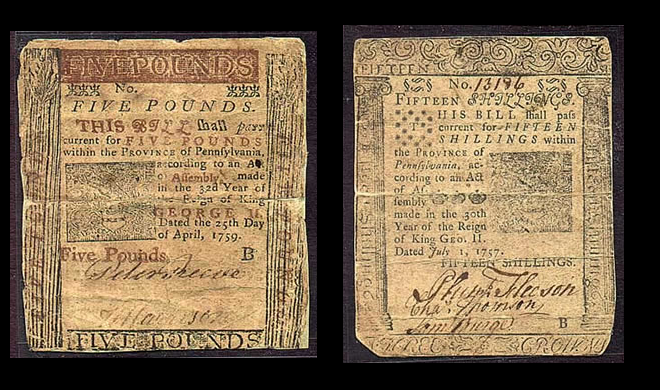
Upon arriving in America, English colonists naturally continued using British currency such as the pound, the shilling, and the pence. But as tensions mounted and they began breaking away from England, colonists found better ways to support the growth and well-being of their new colonies.
You may recall having heard a few of these famous sayings about currency:
"The use of money is all the advantage there is in having it."
"He that is of the opinion money will do everything may well be suspected of doing everything for money."
"A penny saved is a penny earned."
Benjamin Franklin, the author of these quotes, not only used and saved money but he printed it, too. Currency was essential to life in the 18th century just as it is to life today. At the time the following currency was issued, money needed to be printed in order to support military spending during the French and Indian War.
The five-pound note (equal to 100 shillings) bears the date April 25, 1759. One hundred thousand pounds in legal tender bills were issued on April 25, 1759, to be valid until March 1, 1767. This was later extended until October 15, 1769. The Penn family's coat of arms appears on the front of the bill and a nature print is on the back. Benjamin Franklin and David Hall printed the bills in Philadelphia. The spelling of "Pennsylvania" differs on most of the denominations of the notes, and it is thought that Franklin purposely did this to deter counterfeiting.
The 15 shilling note is dated July 1, 1757. The first of this series of bills was issued on January 1, 1756, and the last in May of 1758. Franklin and Hall are responsible for the printing of the bills. The Penn coat of arms is on the front of the bill, and a nature print with typeset borders is on the back. Three crowns, pictured after the words "Act of Assembly," represent the denomination of the bill and the words are also written at the bottom of the front of the note. These three crowns also appear below Hall's name on the back of the bill.
Note: The objects pictured above are part of The Franklin Institute's protected collection of objects. The images are ©The Franklin Institute. All rights are reserved.





